Leonardo articles
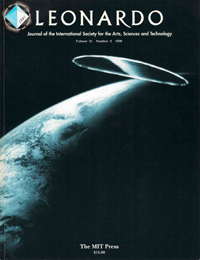
Arthur Woods, Cosmic Seed, 1995-1997 Leonardo, 1998
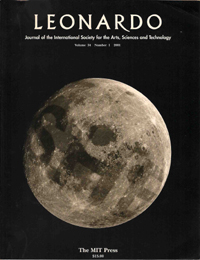
Liliane Lijn, SHE: Space Poem to the Moon Goddess, 1992-2000 Leonardo, 2001
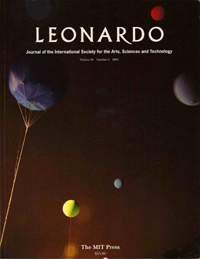
Daniel Goods, Star Field, Leonardo, 2005
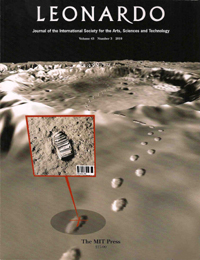
Danqing Shi, Cinderella Lunar Mission, 2008 Leonardo, 2010
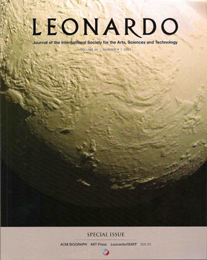
Martin John Callanan, A Planetary Order (Terrestrial Cloud Globe), 2012 Leonardo, Vol. 45, n°4, pp.380-381, 2012
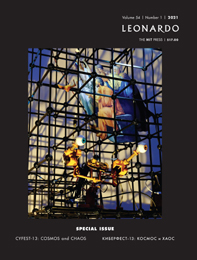
Cosmos and Chaos, special issue in collaboration with Cyfest13, 2021 Leonardo, Vol. 54, n°1, 2021, bilingue English-Russian
List of the articles published in the journal Leonardo, since 1970, listed by alphabetical order.
Arcadias Laurence, Corbet Robin, Animating Fermi - A Collaboration between Art Students and Astronomers, Leonardo, Vol. 48, n°5, pp. 484-485, 2015
Undergraduate animation students at the Maryland Institute College of Art teamed up with scientists from the Fermi Gamma-ray Space Telescope to produce a set of animations on several astronomy topics. Here the authors describe the process and discuss the results, educational benefits and the cross-cultural experience. These animations are available for free online.
ARNHEIM Rudolf, Outer Space and Inner Space, Leonardo, Vol. 24, N°1, pp. 73-74, 1991
The author guides the reader on a psychological trip from the time when humans viewed the earth as the center of an encapsulated, defined universe, to the more recent time when satellites first showed us an outside view of the earth, bringing a redefinition of the ideas of outer space and inner space.
Arns Inke, Zero Gravity, Anti-Mimesis and the Abolition of the Horizon. On Cosmokinetic Cabinet Noordung's "Postgravity Art", Leonardo, Vol.52, n°1, pp. 17-22, 2019
This article presents the work of the retro-utopian Slovenian performance and theater collective Cosmokinetic Cabinet Noordung and its effort to abolish mimetic art in zero gravity ("postgravity art"). It describes the origin of a space station rotating around its own axis (designed in 1928 by Hermann Potocnik Noordung in The Problem of Space Travel); questions the relationship between zero gravity and the historical avant-garde (especially Suprematism) as postulated by theater director Dragan Zivadinov; and sketches the past, present and future of the collective's 50-year project Noordung 1995-2045.
Betencourt Michael, The Semiotics of the Moon as Fantasy and Destination, Leonardo, Vol.48, n°5, pp.408-418, 2015
This essay surveys a 20-year period of the author's sutido-based research into "spatial montage" and windowing, elaborating on his use of space imagery in a symbolic system describing the critique of fantasy ::reality through symbols that are still used in the contemporary world-how the mythic dimensions of interpreting the "heavens" collide and contradict contemporary scientific interpretations. "Visionary" art is the dynamic focus, with the Moon as the central icon, providing a direct means for the author to consider ambiguities and complexities of symbolic transformation: earlier descriptions of heavens and Earth provide a visionary subtext to scientific exploration. The author considers himself a "revisionary" artists whose work engages the implicit semiotics of visionary film/visual music to problematize the pseudo-scientific theoreis found there.
BROWN Robert A., "A Call for an Education Initiative at NASA: Remembering the Road to Hagerstown", Leonardo, Vol. 24, n°3, pp. 345-350, 1991, Oxford, Pergamon Press
Invited to address an awards banquet in Hagerstown, Maryland, honouring outstanding educators in the community for their efforts on behalf of young people, the author prepared for his speech by thinking about the meaning of frontiers, pioneers, technological innovation, discovery, science and — especially — the grand tableau of American exploration. He shares here his vision for the U.S. space program, a future that could take us all to the Moon and Mars and far beyond.
Boland Howard, Cinti Laura, "The Martian Rose", Leonardo, Vol.42, n°2, pp.178-179, 2009
This artwork explores extreme environments and life beyond terrestrial settings. Using a planetary simulation chamber, a rose was exposed to Martian environment for six hours at the Mars Simulation Laboratory, University of Aarhus, Denmark.
Boyle Colleen, "You Saw the Whole of hte Moon: The Role of Imagination in the Perceptual Construction of the Moon", Leonardo, Vol.46, n°4, pp. 246-252, 2013, Cambridge, MIT Press
The author offers a short history of how our perceptual relationship with the Moon has changed over time. Examples of lunar imaging by Early Renaissance painter Jan Van Eyck, Leonardo da Vinci, Galileo, 19th century photographer James Nasmyth and NASA's Ranger and Lunar Orbiter missions of the 1960s reveal ways in which our perception of the Moon has changed. Images of the Moon produced by technology remain far from "complete" —they are akin to fragments, sketches or models, providing information upon which the imagination can build. How we imagine the Moon, the auhtor argues, is symbiotically linked with our representations of it; we only perceive the truly complete, whole Moon in the non-localized zone of our imaginations.
Clar Richard, Space Flight Dolphin: AnArt-and-Technology Payload for the Space Shuttle, Leonardo, Vol. 26,N°4, pp.293-296, 1993
The author describes the interdisciplinary aspects of Space Flight Dolphin, an art-in-space project designed to be deployed from theU.S. Space Shuttle. A proposal for establishing contact with extraterrestrialintelligence, as well as for linking different cultures on our own planet,is outlined. The use of Nitinol, a "shape-memory" alloy, is also discussed.
Coles Chris with Jefferson Alan, "The Space Chronometer: An Orbiting Clock for Humanity", Leonardo, Vol.22, n°2, pp. 201-213, Oxford, Pergamon Press
The author proposal for an orbiting space chronometer, as an entry for the recent Eiffel Tower in Space Competition, has created an opportunity to widen the debate surrounding the future exploitation of space. Some astronomers have shown strong opposition to symbolic artefacts in space visible to the earth's populations. In a preface to their proposals, Chris Cole explains his point of view and offers the "Space Chronometer" as a means to communicate the need for a change of attitude among parties opposed to art in space and to create income to support the further development of space through the medium of an international space foundation.
Comte Pierre, Leonardo in Orbit : Satellite Art, Leonardo, Vol.20, N°1, pp.17-21, 1987
The author describes the development of his ARSAT (Art Satellite) project - an artistic impulse that has found an outlet in space technology. His concept of putting art in space has had an impact that is both cultural and technological. From the seed of his dream have grown designs for future orbital stations.
Comte Pierre, The ARSAT Saga: The Adventures of an Art-Science Space Concept, Leonardo, Vol. 26, N°1, pp. 33-35,1993
The author reviews the progress of the ARSAT project since his last article on the subject in 1987. Both the practical concerns and the conceptual themes of the project are discussed.
Consolmagno Guy J., Astronomy, Science Fictionand Popular Culture : 1277 to 2001 (and Beyond), Leonardo, Vol.29,N°2, pp.127-132, 1996
Historically, developments in astronomy and changes in social environment share inspired new styles of science fiction. In return, popular culture has gained from science fiction an understanding of astronomy and of humankind's place in the universe. However, approaches to plot and character in science-fiction stories colour the presentation of astronomical discoveries, altering the way that popular culture views science fiction's message about the universe and the self in sometimes subtle ways.
Cooperstein Shana, "Imagery and Astronomy: Visual Antecedents Informing Non-Reporductive Depictions of the Orion Nebula", Leonardo, Vol. 47, n°2, pp. 129-134, MIT Press, 2014
The author analyses the visual similarities between early astronomy images and advanced practices such as produced by the Hubble Space Telescope (HST). While 19th centuy images generally were supposed to match what an observer could see if s/he were standing behind the telescope, HST public outreach images are not based on any such match, yet such images resemble photographs that do aim to represent what we see. This paper attempts to explain the insistence on producing images that appear to represent visible phenomena. Emphasizing the ways in which non-reproductive photographs deploy conventions that were originally utilized in reproductive photography, the paper seeks to add to the existing literature concerning the non-reproductive capacities of photography.
"Cosmos and Chaos", special issue in collaboration with Cyfest13, Leonardo, Vol. 54, n°1, 2021, bilingue English-Russian
CYLAND MediaArtLab and Leonardo/The International Society for the Arts, Sciences and Technology (Leonardo/ISAST) presents a special issue of Leonardo - "Cosmos and Chaos" (MIT Press).
The special issue of the journal was prepared by curators of CYLAND MediaArtLab and Leonardo/The International Society for the Arts, Sciences and Technology (Leonardo/ISAST). 12 authors contributed to the journal, including Russian and foreign artists, curators, art critics, collectors, biologists, astrophysicists, specialists on the history of the Russian avant garde, independent researchers and lecturers from the world's leading universities. The theme of the issue is "Cosmos and Chaos". The publication is part of CYFEST-13, which also has the theme of cosmos and chaos this year.
Authors: Daniela de Paulis (Netherlands), Alexandra Dementieva (Belgium), Zandrine Chiri (France), Bettina Forget (Canada), Elena Gubanova (Russia), Annick Bureaud (France), Natalia Kolodzei (USA), Priyamvada Natarajan (USA), Saskia Vermeylen (UK), Aleksandra Shatskikh (Russia), Olesya Turkina (Russia), Linda T. Elkins-Tanton (USA), Diana Ayton-Shenker (USA).
A print or electronic copy of the journal can be purchased on the MIT Press website.
The article by Priyamvada Natarajan "Cosmos, chaos and order: map-making as knowledge" may be downloaded free of charge.
Crombrugghe Guerric de, Wilde Frederik de, Artistic Approaches to Design and Manufacturing Techniques Dedicated to Space Applications, Leonardo, Vol. 52, n°3, pp. 236-239, 2019
Space exploration is undergoing exciting disruptive change, both through the advent of new business models and through the development of innovative technologies. As a consequence of this accelerated activity, innovative design and manufacturing techniques dedicated entirely to space exploration and exploitation are slowly emerging. These go beyond the simplistic approach of considering space as a harsh environment and rather offer solutions adequately developed for alien environments such as interplanetary space or planetary bodies. As demonstrated in this paper, the art community is particularly relevant to support of these efforts. The authors present a conceptual artwork designed from the interplay of materials and local astrophysical conditions. This evolving sculptural installation uses the extreme lunar surface conditions as enablers rather than constraints.
DAMJANOV Katarina, "Lunar Cemetery: Global Heterotopia and the Biopolitics of Death", Leonardo, Vol. 46, n°2, pp. 159-162, 2013
The burial of human remains on the Moon conjures up the idea of a lunar cemetery. This paper reviews related artistic projects and practices and situates the concept of the lunar cemetery in relation to Michel Foucault's articulation of the notions of heterotopia and biopolitics to explore the implications of perceiving the Moon as a globally shared space populated by the dead. The author also suggests that the possibility of a cemetery on the Moon reveals peculiar biopolitical approaches toward lunar space, in which death is used to uphold its heterotopic potential and support the envisioning of prospects for humanity's future beyond the globe.
Davis Joe, The Last Gateway Specials: The Space Shuttle and the Artist, Leonardo, Vol.24, N°4, pp.467-469, 1991
The author discusses procedural problems over topics such as "practicalbenefits" and "scientific value" that were encountered by both scientistsand artists in seeking to include works of art on the space shuttleflight manifest.
DeVito Carl L., Languages, Science and the Searchfor Extraterrestrial Intelligence, Leonardo, Vol. 25, N°1, pp.13-16,1992
In 1992, the 500th anniversary of the voyages of Christopher Columbus,a group of researchers in the United States, working under a grant from NASA, will begin conducting a search for intelligent extra-terrestrial radio signals. The author discusses a method of constructing a language, based on the rudiments of logic, mathematics and the physical sciences, that could be used to successfully communicate with beings from other planets.
Dick Steven J., Other Worlds : The Cultural Significanceod the Extraterrestrial Life Debate, Leonardo, Vol.29, N°2, pp.133-137, 1996
The extra-terrestrial life debate has greatly influenced science, popular culture and both secular and theological worldviews. Today it comprises anon-anthropocentric worldview of its own, here termed the "biophysical cosmology". This cosmology is still unverified, but if extra-terrestrial intelligence is discovered, the cultural impact of the debate thus far will have been but a minor prelude.
Divita Robert J., Divita Edward L., Intaglio Printsof Scientific and Technological Subjects: A Joint Project of An Artist AndA Research Engineer, Leonardo, Vol. 11, pp.181-186, 1978
The authors, brothers, one an artist and the other a space researchengineer, collaborated on the production of a series of intaglio printsdealing, as a conceptual whole, with new scientific and technological subjectsand with their social implications. The goals of the project, the introspectivereasoning of the collaborators, the content of the prints and the manner in which the content was treated are described.
Their belief is that artworks treating scientific and technological subjects not only can give emotional satisfaction to individual viewers but can help them to bring about a better use of science and technology for the welfare of humanity.
Dubois Kitsou, Dance and Weightlessness: Dancer's Training and Adaptation Problems in Microgravity, Leonardo, Vol. 27,N°1, pp.57-64, 1994
In this article the author discusses astronauts' problems of adaptation to microgravity in relation to dancers' body perceptions of space and time. Space sickness hampers the pleasures of being free from gravity; it also handicaps space-mission programs. To prevent space sickness, astronauts are submitted to a training program that is primarily physiological and medical. The author is developing a new training system (complementary to existing training methods), based on dance techniques, for improving the physical consciousness of astronauts -focusing on the body as subjective experience.
Fricks David, Celebration of the Great Red Spot (GRS 79), Leonardo,Vol.30, n°2, 1997, p.158
(artist's statement)
Flow Motion, "Astro Black Morphologies: Music and Science Lovers", Leonardo, Vol. 39, n°1, pp. 23-27, 2006
A compressed series of possible histories of science in modern music, the text outlines the themes of poetic and historic correspondences between music, cosmology and the body that informed the making of Astro Black Morphologies/Astro Dub Morphologies, a multimedia installation and live sound-art performance by Flow Motion in which data from possible black hole Cygnus X1 is transformed into an immersive electronic sound-and-image environment.
Golahny Berta R., "How I came to Paint the Crab Nebula: The Development of Cosmic Themes in my Oil Paintings", Leonardo, Vol.23, n°4, pp. 363-365, 1990, Oxford, Pergamon Press.
The author's paintings of the cosmos are not merely painterly translations of astronomical photographs; rather they have structures revealing metaphors that relate cosmic realities to humankind. Cosmic themes and the techniques that articulate them reach their culmination in her painting Crab Nebula, which is discussed in detail.
Goldring Elizabeth, Desert Sun/Desert Moon and the SKY ART Manifesto, Leonardo, Vol.20, N° 4, pp. 339-348,1987
Desert Sun/Desert Moon and the SKY ART Manifesto body environmental sky art and future sky art projections as interpreted by the SKY ART Conferences, a series of four international conferences spanning a 5-year period from 1981 to 1986. Each SKY ART Conference brought together artists as well as scientists, engineers and public officials from many countries and included exhibitions, lectures, panels, events, installations and a catalogue.
These efforts constituted a determined attempt to document the emerging field of sky art and to discover and projects forms of art in space. Desert Sun/Desert Moon was a series of temporary event sand installations utilizing the temporal landscape of sky and space to evoke at the same time mythic and immaterial dimensions of that sky and space. Complementing these events, the SKY ART Manifesto is a working document drafted at the '86 SKY ART Conference. It offers artistic commitment to the future of art in space as an integral part of international exploration.
The author describes Desert Sun/Desert Moon as it has emerged from the SKY ART Conferences and then presents the text of the SKY ART Manifesto. She comments on the importance of each regarding the practice and potential of sky art.
Goods Daniel E., Revelations at the Jet Propulsion Laboratory, Leonardo, Vol.38, n°5, pp.376-381, 2005
The author's 2 years of developing installations for the Jet Propulsion Laboratory have led him to an appreciation of how similar his thinking and work process are to those of the laboratory's engineers and scientists. For both, certain ideas and processes at first appear crazy and impracticable, but vision and persistence bring them to realization. The three installations described in this article pertain to a future mission that, if successful, will locate a planet similar to earth and once again change humanity's understanding of its position in the universe.
Gracie Andy, Art, Space and Hyperreality. An Artistic Exploration of Artificiality, Meaning and Boundaries within Astro biological Practice, Leonardo, Vol. 49, n°1, pp.6-13, 2016
A dual exploration of scales both massive and minuscule has allowed the author to create artworks and experiments that combine cultures of microscopic organisms and at a from space probes and planetary landers. Meanwhile, a gradual increase in the author's laboratory practice has led to a familiarity with in vitro processes and a corresponding theoretical examination of their significance and place in the cultural milieu. Central to these developments in the author's practice has been the emergence of notions and understandings of simulation theory that unify both nature-technology relationships and ongoing work with organic and living materials. The author describes his artistic experiments with hybrid ecosystems, robotics, artificial intelligence, space exploration and astrobiology and the threads and themes that have persisted throughout them.
Grant Jane, "Soft Moon: Exploring Matter and Mutability in Narratives and Histories of the Earth-Moon System", Leonardo, Vol. 46, n°5, pp. 432-438, MIT Press, 2013
Theories of the formation of the Earth-Moon system allow us to understand not only our historical relationship to science and observation but also how we have perceived ourselves in the context of the vastness of the universe. In this paper the author discusses her work Soft Moon -a computer-generated film that explores the mutual attraction of two planetary spheres, with reference to the story of the same name and other works by Italo Calvino and by Stanislaw Lem. The development of the film is inter-contextualized with a series of ancient and modern historical theories of the formation of the Earth-Moon system.
Griffin Joanna, "Moon Vehicle: Reflections from an Artist-Led Children's Workshop on the Chandrayaan - A Spacecraft's Mission to the Moon", Leonardo, Vol45, n°3, pp. 219-224, 2012, Cambridge, MIT Press
This article reflects on the journey to the Moon of the spacecraft Chandrayaan-1 as it was interpreted through an artist-led workshop. The workshop participants were a group of children who lived close to where Chandrayaan was built and some of the engineers and scientists responsible for creating the spacecraft. Insights from the workshop show how a mission to the Moon draw a on both the technological and the imaginative; they also have bearing on the relative agency of these individuals to contribute to the Moon missions in ways that are personally meaningful to them.
Hardy David A., Painting: The Impact of Astronautics and Science Fiction on my Work, Leonardo, Vol.9, pp.95-98, 1976
The author presents the main lines of his work since 1952 as a painter of pictures dealing with astronautical and astronomical subjects. The contents of several of his pictures are discussed.He points out the distinction that he recognizes between "space age" art and science fiction art -primarily that in the former fewer liberties are taken with knowledge available on a subject depicted. Since about 1970 he also has made paintings of a science fiction type.
In the remaining parts of the article he reviews briefly the historical precedents for science fiction art based on his years of being a science fiction devotee and gives his estimate of the quality of some of this art at present in Britain, the U.S.A. and the U.S.S.R.
Hartal Paul, Homage to a Blue Planet: Aeronauticaland Astronomical Artworks, Leonardo, Vol. 25, N°2, pp. 211-215,1992
The author views space exploration as a human activity that transcends science and technology. He suggests that the ecological objective to save the earth is a beautiful and moral mission in which the arts should playa central role. Thus, aeronautics includes planetary consciousness; ethicsis aesthetics. The author discusses space art, star sailing and his cosmological paintings.
Heivly Michael L. with Reed Michal, The Space Betweenthe Real and the Imagined: Microwave Sculpture in Deep Space, Leonardo, Vol. 25, N°1, pp.17-21, 1992
The author describes his journey from two-dimensional art forms involving the ideas of "space" and "place" to his current medium, which involves the translation of landscapes into musical sound-pattern compositions. These compositions, when transmitted in the form of microwaves, remain in deep space for millennia. The transmissions attract many participants and have become spectacles of sound, poetry, dance and performance.
Impey Chris and Green Heather, "The Living Cosmos: A Fabric That Binds Art and Science", Leonardo, Vol. 43, n°5, pp. 435-441, 2010, Cambridge, MIT Press
The authors, an astronomer and an artist, have collaborated on a series of seven miced-media cosntructions and prose pieces that follow the flow and thems of Impey's book on astrobiology, The Living Cosmos. The book summarizes recent research on astrobiology from the origin of life on Earth and its environmental range on this planet to the search for life in the solar system and beyond. The artist's work encapsulates these ideas with its use of material objects, textures, images and metaphors that mirror the elements of the scientific approach to astrobiology.
Lee Soo-jin, Wohn Kwang-yun, "The Media-Aet Exhibition Ten YearsAfter-v4.0-OuterSpace", Leonardo, Vol.41, n°5, pp. 454-459, 2008
Ten Years After is an annual media art exhibition based in Korea. In 2006, its theme was "Outer Space".
Le Marchand Guillermo A., Lomberg Jon, "Universal Cognitive Maps and Search for Intelligent Life in hte Universe", Leonardo, Vol.42, n°5, pp.396-402, 2009, Cambridge, MIT Press
For almost 50 years, the Search for Extra-terrestrial Intelligence (SETI) research program was pursued under the hypothesis of the universality of the physical laxs in the cosmos. The authors call attention to some epistemological issues that make it necessary to seek other aesthetic, spiritual and ethical "cognitive universals". They propose the participation of a broader community of scholars from natural, social, artistic and humanistic disciplines to explore all the possible "universal cognitive maps" that eventually might favors the detection of extra-terrestrial intelligent life.
Mackinnon Lee, "Toward an Algorithmic Realism: The Evolving Nature of Astronomical Knowledge in Representations of the Non-VIsible", Leonardo, Vol. 47, n°3, pp. 225-231, MIT Press, 2014
This paper explores the gathering of radio, optical and electromagnetic wavelength data in assembling images of the Crab Nebula (1844-2000). The author considers the expanding fields of astronomical and astrophysical knowledge to which such data analysis has given rise. She suggests that the data that makes such imaging possible moves us further from conventions of the optical real toward an algorithmic realism, alluding to time-scales that delimit and circumvent human time. Thus Cartesian metaphysics is displaced- the human becomes one agent among many in a process of algorithmic inference.
Malina Frank J., On the Visual Fine Arts in the Space Age, Leonardo, Vol.3, pp.323-325, 1970
Marmor Kathy, "Bird Watching: An Introduction to Amateur Satellite Spotting", Leonardo, Vol.41, n°4, pp.317-323, 2008
Space satellites are invisible instruments of globalization that influence governmental policies. This paper examines remote sensing satellites as optical devices capable of redefining human cognition. They represent accessibility and openness through the more agreeable paradigm of transparency. However, transparency, like surveillance, is based on the interconnection between power, knowledge and perceptual experience. Artists use a variety of tactical practices, including amateurism, to tease apart these connections. Amateurism dedicates itself to the politics of knowledge. The author concludes, based on examples of her work and that of others, that the potential for political intervention exists when knowledge is paired with action.
Marsiske Hans-Arthur, "The Legacy of Columbus", Leonardo, Vol.43, n°2, pp. 176-177, 2010, Cambridge, MIT Press
By giving the name "Columbus" to the European Space Laboratory the European Space Agency (ESA) has put itself in the tradition of European explorers and erected a historical monument in space. But this monument is incomplete, since it ignores the high price that humanity has paid for European expansion. If space exploration is really about humanity going to space and not only a few technologically developed nations, as representatives of ESA repeatedly declare, then another monument should be added to the European Space Laboratory.
Mast Sara, Jellison Jessica, O'leary Christopher, Bolte Jason, Stillwell Cindy, Kankelborg Charles, Yunes Nicolás, Shapiro KEY Joey, Raley Jessica, Black (W)hole, Leonardo, Vol. 49, n°1, pp.19-24, 2016
Black (W)hole is an immersive art installation created collaboratively by artists and scientists utilizing data visualization of an extreme mass ratio inspiral (EMRI) and the sonification of its emitted gravitational waves in an experiential work of "art-science" and science education. The sensory-rich environment of the installation engages mind and body, expanding and enriching the participant's capacity to imagine and wonder about the beauty and meaning of this highly abstract astronomical object, the black hole. The work investigates both historical and current gravitational wave astronomy, illustrating our 21st-century understanding of the cosmos.
McCray Patrick, Of Gravity and Geese, Leonardo, Vol.50, n°3, pp.347-351, 2017
In the "End Note" section of the journal, the author reflects on Agnes Meyer-Brandis's Moon Geese.
McLEISH Peter, The Historic Search for the Red Sprites: Art Meets Science in Lightning's Angels, Leonardo, Vol. 38, No. 2, 2005, pp. 109-113
Sprites are fleeting, luminous shapes that shoot into the upper atmosphere during large thunderstorms as lightning simultaneously reaches down to Earth. For at least a century, scientists have attempted to confirm and explain the existence of sprites with visual images and data. The author's series Lightning's Angels supplements the documentation of sprites by exploring the properties of this natural phenomenon through digitally enhanced oil portraits set to music and displayed in a large-scale multimedia format, such as at a planetarium.
Miller Barbara, Transdimensional Space. From Moholy-Nagy to Doctor Who, Leonardo, Vol. 52, n°2, pp.128-134, 2019
More than ever, Moholy-Nagy's influence circulates within contemporary art and visual media. In this essay, the author reconsiders his extended influence in regard to the complex scientific theories of space-time and molecular forces he invokes in Light-Space Modulator. To do so effectively and provocatively, the author brings on board a fictive resource: "Doctor Who". Like the TARDIS, Moholy's kinetic sculpture is conceptually a transdimensional apparatus that figuratively bores through time and space to connect past, present and future and resonates with today's perception of space-time-light entanglement.
Miller Ron, The Archaeology of Space Art, Leonardo, Vol.29, N°2, pp.139-143, 1996
The origins of space art are traced to the first realization that there are worlds other than the earth - a time when speculation was rife as to just what the nature of these other worlds might be. The first artwork that tried to realistically depict interplanetary space and the surfaces of other planets did not appear until the publication of Jules Verne's classic novels. The subsequent burgeonning of both astronomical knowledge and the new literary genre of science fiction increased the need for artists specializing in realistic depictions of outer space, other planets and spacecraft. Space art proved to be a major influence on the public's perception of the universe as well as on the development of space exploration. Today's space artist is considered by astronomers and space scientists to be a valued colleague.
Nieman Adam, Welcome to the Neighbourhood: Belonging to the Universe, Leonardo, Vol.38, n°5, pp.383-388, 2005
Space travel could be an experience available to every one. This paper describes Welcome to the Neighbourhood, a combination of sculpture and multimedia designed to help people inhabit the solar system (without leaving the earth). The project aims to empower astronomers and non astronomers alike to form an authentic conception of their place in the cosmos. The author discusses the sculptures that inspired the idea for the project, including the largest known kinetic sculpture ever built (60 light-year across), and then outlines Welcome to the Neighbourhood in the context of a broader discussion of public engagement with science and the role of space art in transforming people's experience of "being in the universe".
Orion Ezra, Sculpture in the Solar System: From Geologically Based Earthworks to Astro-Sculpture, Leonardo, Vol. 18,N°3, pp.157-160, 1985
The author conceives of the geologic structures in the Negev desert in southern Israel and the Sinai desert as "launching pads" for the mind. This concept first evolved from his interpreting global plate tectonics as sculpture and then motivated him to produce a stone staircase in the Annapurna basin of the central Himalayas. The process has culminated in a project proposal to the U.S. National Aeronautics and Space Administration for the execution of sculptural works by the future Mars Rovers as a first step towards sculpture on other planets in the solar system.
Osaka Takuro, Art in the Space Age: Exploring the Relationship between Outer Space and Earth Space, Leonardo, Vol.37, n°4, 2004, pp 273-276
The author's interest in Space Art has taken several forms, including project proposals for the effective use of the International Space Station, research on the theme of the possibility of art in outer space, and conducting interviews with astronauts. He has also performed experiments in a micro-gravity environment generated by parabolic flight. This article provides an account of his plans and the results of these experiments.
Ostergaard Edwin, "Moon Music: A Composition of Art and Science in Dialogue", Leonardo, Vol.43, n°3, pp. 223-228, 2010, Cambridge, MIT Press
Leonardo da Vinci's careful descriptions of the reflection of light by the moon inspired the author to compose a piece for choir on ways of perceiving the moon. In The Two Moons, Leonardo's words are contrasted with two additional texts: facts from a textbook on astronomy and a poem by Denise Levertov. The author discusses the challenge of transforming text and idea into musical sound. Further he discusses exploring natural phenomena by means of parallel efforts in art and science.
Pacholczyk Jozef, Music and Astronomy in the Muslin World, Leonardo, Vol.29, N°2, pp.145-150, 1996
In the Muslin world, the relationship between music and astronomy can be seen on two levels. On one level, the connection is indirect, involving an underlying system of symbolism in numbers, proportions and geometric figures that penetrates most areas of Islamic art and scholarship, such as mathematics, geometry, alchemy and medicine. It can be understood as a unifying element within Islamic culture. On another level, the connection between music and astronomy is direct, with astronomical concepts directly applied to music and some musical concepts applied to astronomy. In both cases the relationship can be understood only in the context of the Islamic culture, its philosophy and art.
De Paulis Daniela, OPTICKS and Visual Moonbounce in Live Performance, Leonardo, Vol.49, n°5, pp.438-439, 2016
OPTICKS is an art project realized by interdisciplinary artist Daniela de Paulis, in collaboration with the CAMRAS radio amateur association based at the Dwingeloo radio telescope in The Netherlands. The project is presented as a live audio-visual performance during which digital images are transmitted as radio signals to the Moon from a radio station in Brazil, the U.K., Switzerland, Poland or Italy. The signals reflected by the Moon's surface are received by the Dwingeloo radio telescope, converted back into the original images and projected live at an exhibition venue. The project uses Visual Moonbounce, an application of the Moonbounce technology, developed by the artist in collaboration with the CAMRAS team during her residency at the Dwingeloo radio telescope.
Pesek L, An Artist in Modern Times: On Extra-terrestrial Landscapes, Leonardo, Vol. 5, pp.297-300, 1972
The author discusses the uncertain meaning of the terms modern and freedom whenever applied but especially in art. He is of the view that neither of the terms have much significance, although they are so frequently used.
His outlook is the result of painting for many years representational landscapes of the planets of the solar system. He describes the problems he has encountered in making such paintings. He defends his conviction that paintings of this kind still have value, in spite of close-up photographs now available of the lunar surface and better ones of Mars than could be obtained before the space age by means of telescopes on the Earth. Furthermore he continues to obtain aesthetic inspiration from extra-terrestrial sources.
Petersen Stephen, Sculpture in Space. Flotation and Levitation in Postwart Art, Leonardo, Vol.51, n°5, pp. 498-502, 2018
The idea of sculpture with no visible contact with the earth, hovering in space without the usual vertical and horizontal orientation, arose in contemporary art practice during the postwar decades, amid the Cod War race for space. In Milan, Paris, Düsselforf and New York, an array of floating art projects were attempted both inside -and outside- the art gallery. These artistic experiments offered a counterpoint to the first satellites and manned spacecraft, using simple technologies including magnets and balloons to address complex aesthetic issues raised by the outer-space environment and, in particular, the zero-gravity field. By the late 1960s, free-floating "aerial" and "pneumatic" art had become an international trend, reflecting a new conception of art's meaning during a time of cultural and technological change.
Philippe Jean-Marc, "Space Art: A Call for a Space Art Ethics Committee", Leonardo, Vol. 23, n°1, pp 129-132, 1990, Oxford, Pergamon Press
The author proposes the creation of a world-wide committee for Space Art projects and both suggests the principles by which such a committee should function and addresses some necessary practival (above all, financial) considerations. He proceeds from a conception of 'Space Art and its stakes' that resulted from the author's experience as a pioneer of Space Art and from his participation in numerous international conferences that have served as springboards for new ways of thinking.
Pietronigro Frank, "Research Project n°33: Investigating the Creative Process in a Microgravity Environment", Leonardo, Vol. 33, n°3, 2000
The author discusses his creation of art in a microgravity environment as part of the 1998 NASA Student Reduced Gravity Flight Program. He discusses his three-dimensional "drift paintings", which floated in the air along with his body in microgravity. The author posits that the transcendent quality of the creative process can help keep the human spirit alive during long-term space missions.
Poleskie Steve, Art and Flight: Historical Origins to Contemporary Works, Leonardo, Vol.18, n°2, pp.69-80, 1985
The author traces the origins of flight in early works of art and literature, where flight is seen centuries before it existed as a thing of function. In more recent times artists have begun to use the actual tools of flight as tools for making art. This article documents the work of some of these artists and the author's own Aerial Theatre, in which he flies an aerobatic biplane trailing smoke to perform multidimensional events in the sky.
Puncer Mojca, Advanced Constructivism and Postgravity Art. Theoretical and Philosophical Implications, Leonardo, Vol.51, n°5, pp. 475-481, 2018
This article discusses art's potential in outer space through a dialogue between European and Russian avant-garde traditions, and postgravity art project by Dragan Zivadinov, Dunja Zupancic and Miha Tursic. They enact a 50-year theater performance, Noordung::1995-2045, with the help of high tech, Suprematism and Constructivism. The performance is based on five replays every 10 years with the same actors and on technological substitutes of the deceased. The project has several topical theoretical implications. The author explores its key philosophical aspects and presents new potentialities for a systemic cognitive model for image and space conceptual transformations within the context of contemporary art and aesthetics.
Punt Michael, Blassnigg Martha, Surman David, "From Méliès to Galaxy Quest: The Dark Matter of Popular Imagination", Leonardo, Vol. 39, n°1, pp. 12-18, 2006
The authors argue that an interrogation of cinema can reveal the fragility of our knowledge and the underlying imperatives that the social construction of space responds to. A revisionist overview of the issue of professional interfaces in the popular arts is followed by a discussion of the influence of space technology and natural space phenomena on human personal and collective belief systems in order to open the way for an outline of the concept of participatory cultures and the relationships between fiction and science.
Reiche Claudia, Von Oldenburg Helene, "What is the MARS PATENT and What does it do?", Leonardo, Vol. 39, n°1, pp. 19-22, 2006
The authors invite readers and others, including aliens (provided they claim to have female first names), to submit "things" to the MARS PATENT project for interplanetary exhibition on Mars and on the Internet. The MARS PATENT High Reality Machine will teleport sculptures, theories, web art and other things, imaginable or not fully imaginable, to the exhibition site on the red planet. The authors have established the Oldenburg-Reiche Prize, an open competition challenging artists, scientists and others to come up with a satisfying explanation for how the High Reality Machine works.
Roth Tim Otto, "Cosmic Revelation", Leonardo, Vol.42, n°3, pp.288-289, 2009
As a collaboration by the KASCADE experiment and Tim Otto Roth, Cosmic Revelation is a minimalist light art project and a scientific experiment as well. In a field of 16 flashing mirror sculptures connected to the KASCADE detector field at Forschungszentrum Karlsruhe (Germany) the impact of high energetic cosmic rays on earth can be bodily experienced.
Roth Tim Otto, "From the Distant Past", Leonardo, Vol. 46, n°5, pp. 492-493, MIT Press, 2013
In collaboration with the Space Telescope Science Institute, the German artist Tim Otto Roth presented astronomical spectra as a core component of art exhibits in Venice, Baltimore, and New York City. "From a Distant Past" is not only a light based art and science project in public space about the origins of the universe, it is also an artistic reflection on the phenomenon of color by the means of concept art using laser light as a minimalist tool of graphical notation.
Saad-Cook Janet with Charles Ross, Nancy Holtand James Turrell, Touching the Sky: Artworks using Natural Phenomena, Earth,Sky and Connections to Astronomy, Leonardo, Vol. 21, N°2, pp.123-134, 1988
In separate conversations, four artists discuss their monumental-scaleworks involving natural phenomena. The projects of Charles Ross, Nancy Holt, James Turrell and Janet Saad-Cook are at various stages of completion, ranging from preparatory stages to works already completed. The artists speak about their own creative process and about their personal vision for their art.
Saad-Cook Janet, Sun Drawing: Sculptures of Reflected Sun light Connecting the Earth and Sky, Leonardo, Vol.22, N°2,pp.151-158, 1989
The author explains the development of her sculptural process called Sun Drawings. Using highly reflective materials that are bent in various ways and placed to intersect with direct sunlight, she creates brilliant forms of light that are refracted onto surfaces in the surrounding environment. With the rotation of the earth the angle of sunlight changes, and these light-forms undergo a subtle metamorphosis. The author describes temporary installations at the ruins of prehistoric southwestern American Indian sun-marking sites as well as installations in museums. She also describes the development of her materials from flexible plastic films to permanent materials such as dielectrically coated glass and mirrored bronze and steel. Her current work-in-progress is the Sun Drawing Project, a large hemispherical structure in New Mexico that will house a permanent Sun Drawing active throughout the full yearly cycle of the sun
Shi Danqing, "Cinderella Lunar Mission: Everyone Has a Chance to Set Foot on the Moon", Leonardo, Vol.43, n°3, pp. 218-222, 2010, Cambridge, MIT Press
The author compares the original story of Cinderella with the modern fairy tale created by the news media in covering the Apollo Program. This compariston builds the basis for the design of Cinderella Lunar Mission, a pseudo-lunar mission consisting, variously, of an installation, fake news reports, a lunar mission network game and real-world action www.cinderellalunarmission.com. Inspired by Cinderella's glass slipper, the exclusive sign of her identity, Cinderella Lunar Mission examines the idea of shifting identity and ways of fabricating new fairy tales using such digital technologies as progammatic text, network games and barcode identification.
Shi Weili, Terra Mars: When Earth Shines on Mars through AI's Imagination, Leonardo, VOl.52, n°4, pp. 357-363, 2019
Terra Mars presents artistic renderings of Mars with visual reference to our very own planet Earth. The author trained an artificial neural network with topographical data and satellite imagery of Earth so that it can learn the realtion between them. The author then applied the trained model to topographical data of Mars to generate images that resembles satellite imagery of Earth. This project suggests a new approach to creative applications of artificial intelligence -using its capability of remapping to broaden the domain of artistic imagination.
Speed Chris, "Developing a Sense of Place with Locative Media: An 'Underview Effect'", Leonardo, Vol.43, n°2, pp. 169-174, 2010, Cambridge, MIT Press
The author explores the potential for locative media to offer a sense of a place. Frank White's "Overview Effect" is cited as a model for perceiving a sense of place in a global context. The paper describes the inherent limitations of Cartesian representations of space in supporting this perception. Finally, the author proposes that the capacity of locative media to connect people offers a path for a creative reconciliation between space and time. The author proposes that this kind of connected model may provide an ''Under view Effect" and foster an appreciation of a global sense of place.
Stoeger William R., Astronomy's Integrating Impacton Culture : A Ladrièrean Hypothesis, Leonardo, Vol.29, N°2,pp.151-154, 1996
The author summarizes the framework that Jean Ladrière has proposed for describing and understanding the impact that science and technology have on cultures and employs this framework to characterize the cultural influence of astronomy and cosmology. The author hypothesizes that astronomy and cosmology are similar to other areas of science and technology in their contribution to cultural and social evolution and change at the level of destructuration. However, at the level of positive restructuration, they play a unique integrative role in a number of ways - by restoring a more open-ended and uncontrollable sense of the future and of temporality, by acting as an invitation to self-transcendence and by disclosing new horizons and limits.
Turner Ralph J., Extra-terrestrial Landscapes through the Eyes of a Sculptor, Leonardo, Vol. 5, pp. 11-17, 1972
The author tells of his experience as an interpreterof photographs of the Moon taken from astronomical observatories, fromspace craft and by the astronauts of the Apollo flights.
He discusses three scale relief models of the followingselected lunar areas : (1) "Alphonsus Alpha", the central peak of the crater"Alphonsus" ; (2) the northest rim of the crater "Tycho", including lavalakes on its flanks ; and (3) "Schröter's Valley" (near thecrater "Aristarchis". The first contour map made of a portion of thelunar surface as generated from a model is described, as well as hisscale model of Jupiter in color. Two examples of his art work affectedby these experiences are included.
Finally, he presents his views on art in the future, especially, as he expects it to be influenced by extra-terrestrial space exploration.
VAKOCH Douglas A., Signs of Life beyond Earth:A Semiotic Analysis of Interstellar Messages, Leonardo, Vol.31, n°4,pp.313-319, 1998
Previous proposals for wommunicating with extraterrestrials have relied heavilyon pictorial messages, regardless of whether communication is via electromagneticradiation or by spacecraft-borne messages. Pictorial messages can be categorizedaccording to whether the pictures can be shown directly or whether they mustfirst be formatted. The author discusses the advantages of direct representationsand critiques the universality of pictorial representation. He proposes analternative to the use of pictures to communicate, drawing on semioticdistinctions. With the author's approach, icnonic representations -in whichthe sign bears a physical similarity to th at which it represents- are showndirectly, rather than in a format that must be reconstructed or decoded.This method of communication is illustrated with messages based onquantum-mechanical phenomena. The advantages of having the content ofa message reflected in the form of the message are detailed.
Vogler Andreas, Jorgensen Jesper, Windows to the World, Doors to Space: The Psychologie of Space Architecture, Leonardo, Vol.38, n°5, pp. 390-399, 2005
Living in a confined environment with minimal external stimuli available, such as a space habitat, is a strain on normal human life and puts great pressure on groups and individuals. Designers working on a space habitat not only must work on its functional role, but also must integrate functionality with mental representation and symbolic meaning. Space connection interfaces such as doors and windows act as "sensory organs" of a building. They allow inside-out communication, but also allow the user to control the flow of light and air, which in a direct or indirect way are communication mediums. In this paper the authors advocate a closer connection among architecture, anthropology and psychology in designing space habitats as part of a new concept of environmental design strategy in space architecture.
Woods Arthur, Bernasconi Marco C., The Orbiting Unification Ring-Space Peace Sculptures: Progress Report on Global Artin Space, Leonardo, Vol. 24, N°5, pp. 601-606, 1991
The authors discuss the progress of the Orbiting Unification Ring-Space Peace Sculptures (OUR-SPS), a project of the OURS Foundation. The OUR-SPS have been designed in accord with both the astronomical sign of the planet Earth and an ancient sign of peace and unity. The sculptures also communicate to a global audience that the development of outer space is not only beneficial but also crucial to the well-being of the planet.
Specific developments discussed include the evolution of launch arrangements with the space agencies of the United States and the USSR, the selection of contractors and technology and the broadening of artistic collaboration and public awareness through events and exhibitions.
WOODS Arthur, The Cosmic Dancer: Sculpture and the Absence of Gravity, Leonardo, Vol.26, N°4, pp. 297-301,1993
As human civilization is extended beyond the planet, its culture will be altered by the conditions of the new environment. This article examines the development of sculpture as a terrestrial art form and the ways in which its creation and perception have been influenced by the "gravity constant". The author discusses the evolution of his Cosmic Dancer sculpture series, from an exploration of multiple resting points on Earth to the infinite perceptual possibilities attainable in the space environment.
Leonardo/Olats
Observatoire Leonardo des Arts et des Techno-Sciences
À propos / About



Pour toute (re)publication, merci de contacter / For any (re)publication, please contact Annick Bureaud: info@olats.org
Pour toute question concernant le site, merci de contacter / For any issue about the website, please contact: webmaster@olats.org
Design Thierry Fournier
© Association Leonardo 1997-2022